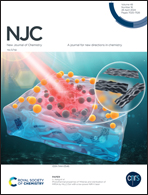Effects of silylene ligands on the catalytic activity of [PSiP] pincer cobalt(ii) chloride for N2 silylation†
Abstract
Three silyl [PSiP] pincer cobalt(II) chlorides 1–3 [(2-Ph2PC6H4)2MeSiCo(Cl)(PMe3)] (1), [(2-iPr2PC6H4)2MeSiCo(Cl)(PMe3)] (2) and [(2-Ph2PC6H4)2MeSiCo(Cl)(LSi:)] (LSi: = {PhC(NtBu)2}SiCl) (3) were synthesized and used as catalysts and their catalytic activity for dinitrogen silylation was studied. Among the three complexes complex 3 was new and was synthesized via the reaction of [PSiP] pincer preligand L1 with CoCl2 in the presence of chlorosilylene via Si–H bond cleavage. The molecular structure of 3 was determined by single crystal X-ray diffraction analysis. Compared to complex 1, complex 2 is the more effective catalyst for dinitrogen silylation and 363 equiv. of N(SiMe3)3 could be reached per Co atom. Further study indicates that using the silylene ligand in complex 3 instead of the PMe3 ligand in complex 1, the catalytic activity of 3 is lower than that of 1. The catalytic mechanism for this catalytic system is proposed with the support of experimental evidence. The [PSiP] pincer cobalt(I) dinitrogen complex was proposed as the active catalyst for dinitrogen silylation.
![Graphical abstract: Effects of silylene ligands on the catalytic activity of [PSiP] pincer cobalt(ii) chloride for N2 silylation](/en/Image/Get?imageInfo.ImageType=GA&imageInfo.ImageIdentifier.ManuscriptID=D4NJ00883A&imageInfo.ImageIdentifier.Year=2024)


 Please wait while we load your content...
Please wait while we load your content...